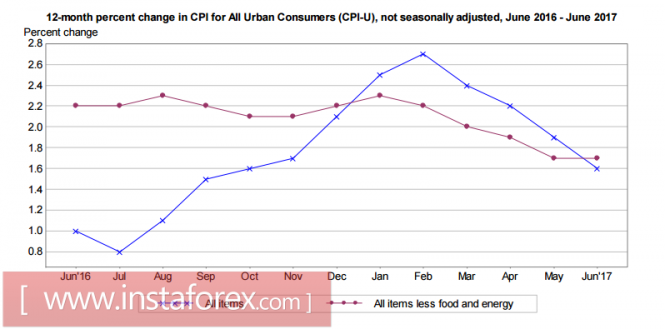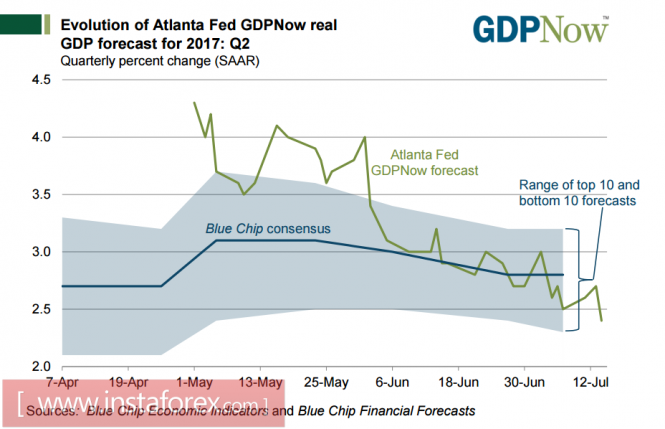The US dollar finished the week with large-scale sales, never seeing a single factor that could support it. The formal reason for the decline in investor confidence was the report of the Bureau of Labor Statistics on inflation, but this was not the only reason.
Consumer prices remained unchanged in June while annual inflation slowed to 1.6% from 1.9% a month earlier. Both indicators were worse than expected.

Also an unpleasant surprise was the decline in retail sales for the second month in a row. Experts expected a slight increase. The slowdown in consumer activity is an alarming factor as it indicates that incoming signals, one after another, about slower economic growth are not accidental and will likely cause a crisis to develop.
The preliminary value of the consumer confidence index according to the University of Michigan was significantly lower than expected at 93.1 points in July against the forecast of 95.0 points and last month's figure of 95.1 points. The subindex of expectations are declining at the fastest rate, indicating that consumers are preparing for a deterioration in the outlook for the coming months.
The GDPNow model from the Federal Reserve Bank of Atlanta forecasts the US GDP growth for the second quarter at 2.4%. This is higher than the result of the first quarter but significantly below expectations. The first estimate, which was presented in May, came out at 4.3%. At the time, it seemed that the positive momentum in the economy will develop but for two months in a row, the key macroeconomic indicators are worse than forecasts.

The Federal Reserve Bank of New York expects that GDP growth will be at 1.9% in Q2. However, this estimate may be too optimistic. At any rate, Fed Chairman Janet Yellen, speaking in Congress, said that achieving an economic growth of 3% "will be pretty hard."
Recalling the basic scenario by the Congressional Budget Office (CBO), the average annual growth is set at 4%. Even in this case, the budget deficit in the next ten years will grow to 1.5 trillion dollars and reach a GDP of 5.2%. Weaker growth will significantly accelerate the development of a negative scenario. It can only be overcome through swift and decisive reforms while the situation develops in the opposite way. As indicated in the report of the Ministry of Finance published on Thursday, the budget deficit in June amounted to 90.233 billion dollar within the nine months of the current fiscal year. The negative balance grew by 31% and reached 523 billion. There is no reason to expect that the situation may change as the collection of taxes is reduced. Against the background of a drop in consumer activity, there is no chance of an increase of tax collection.
Actually, it was the reassessment of the player's prospects for the development of the situation that caused the dollar to fall sharply on Friday. It's not just a matter of low inflation. The fact is that even optimistic models (and the optimistic CBO forecast) do not see good exit scenarios. The Fed may begin to reduce the balance sheets in the coming months. In any case, the preparation of public opinion for this step is being carried out purposefully. Yesterday, the head of the Federal Reserve Bank of Dallas, Robert Kaplan, said that it is necessary to start reducing the Fed's balance sheet "very soon", possibly in September. Low inflation, in his opinion, is temporary. He also added that the achievement of full employment will contribute to higher prices.
The beginning of the reduction in the balance of the Fed means terminating the practice of refinancing revenues. In other words, the Fed will gradually reduce the repayment of government debts which, against the background of a growing budget deficit and a reduction in the collection of taxes, can have extremely unpleasant consequences for the Trump administration. In September, the government should already receive a result regarding the level of borrowing from the Congress. This will exhaust the latest resources for financing current activities and will make them face the prospect of technical default. However, in order for the Congress to meet Trump and raise the ceiling of national debt, it will be necessary to convince him of the feasibility plans for reforming the tax and health policies. It is necessary to present these plans formally.
Thus, for the dollar, there is still no reason to resume growth.
The material has been provided by InstaForex Company - www.instaforex.com